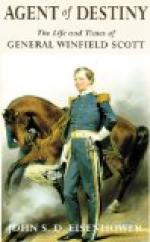As resistance was entirely hopeless, the order was given to retire. The whole line broke in disorder to the river, but there were no boats there to transport them. Two flags of truce were sent to the enemy, but the officer who bore them did not return. Colonel Scott then fixed a white handkerchief on the end of his sword, and, accompanied by Captains Totten and Gibson, passed under the river bluff and started to ascend the heights. They were met by Indians, who fired on them and rushed with tomahawks to assault them. A British officer happily arrived and conducted them to the quarters of General Sheaffe, and Colonel Scott made formal surrender of the whole force. The number surrendered, except some skulking militia who were discovered later, was two hundred and ninety-three. The American loss in killed, wounded, and captured was near one thousand men.
General Van Rensselaer was so mortified at the conduct of the militia that he tendered his resignation. The British general Brock was next day buried under one of the bastions of Fort George, and Colonel Scott, then a prisoner, sent orders to have minute guns fired from Fort Niagara during the funeral ceremonies, which orders were carried out—an act of chivalry and courtesy which greatly impressed the British.
The American officers who had been captured were lodged in a small inn at the village of Newark and divested of their arms, and a strong guard was posted at the door. Two Indians, Captain Jacobs and Brant, sent word that they wished to see the tall American, meaning Colonel Scott. The alleged object of their visit was to see if Scott had not been wounded, as he had been fired at several times at close range. On entering the room, Jacobs seized Scott by the arm and attempted to turn him around. Scott seized the Indian and threw him against the wall. Both then drew their knives, and advancing on the prisoner said, “We kill you now!” The sentinel at the door was not in view, and Scott, making a spring, seized a sword, which he quickly drew from the scabbard, and, placing his back against the wall in the narrow hall, defied his assailants. At this critical moment Captain Coffin, nephew of General Sheaffe and his aid-de-camp, entered the room and caught Jacobs by the throat and presented a cocked pistol to his breast. Both savages now turned on him, and Scott closed in to defend the captain. At this moment the guard entered, and arrested the two Indians and conducted them out of the room.
The volunteer officers and men were paroled and sent home, while the regulars were embarked for Quebec. On the passage to Quebec a priest of a Caledonian settlement reproached Colonel Scott severely for being a traitor to George III. Respect for his profession brought out a mild reply. In 1827, General Scott being at Buffalo on board a Government steamer, the master of the vessel asked permission to bring into his cabin a bishop and two priests. The bishop was recognized as the same prelate who had acted so rudely. General Scott, however, heaped coals of fire on his head by treating him and his party with the greatest courtesy.




